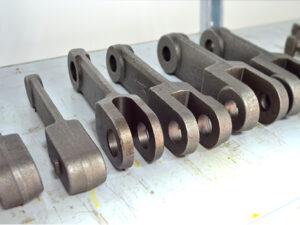Forged Chains
What Are Forged Chains?
A Forged Chain is a type of chain whose individual links are created through the industrial process of forging, as opposed to casting or welding.
Forging involves heating a metal billet (typically high-carbon or alloy steel) to a high temperature and then applying immense compressive force—through a power hammer or press—to shape it into the desired form. This process aligns the metal’s grain structure, making it continuous and unbroken throughout the component’s shape.
The result is a chain link that is incredibly dense, free from internal voids or impurities, and possesses superior mechanical properties compared to its cast or welded counterparts. Forged chains are often recognizable by their robust, solid, and sometimes “hand-forged” appearance.

Key Industries That Rely on Forged Chains
Due to their exceptional strength-to-weight ratio and impact resistance, forged chains are critical components in several heavy industries:
Mining and Quarrying: Used in conveyors for transporting heavy ores, coal, and aggregates, and in hoisting and dragging applications where shock loads are common.
Forestry and Logging: Essential in log hauling, skidders, and slasher decks, where they withstand brutal abrasion and sudden, heavy loads.
Steel Mills and Foundries: Employed in mill conveyors, charging machines, and other high-temperature environments where chains must retain strength under extreme heat.
Marine and Dredging: Used for mooring, towing, and in dredge ladder systems, resisting the corrosive effects of saltwater while handling massive loads.
Construction and Heavy Lifting: Found in cranes, hoists, and other lifting equipment where safety and reliability are paramount.
The Key Benefits of Forging: Why It's Superior
Choosing a forged chain means investing in performance and longevity. The forging process itself imparts several critical advantages:
Superior Strength & Toughness: The compressed and aligned grain flow creates a part that is significantly stronger and more impact-resistant than a cast link, which can be brittle.
Enhanced Durability: Forged chains have excellent fatigue resistance, meaning they can withstand repeated stress cycles over a long period without cracking or failing.
Reliability in High-Stress Environments: The absence of internal defects like sand inclusions or porosity (common in casting) makes forged chains incredibly reliable. There is no weld to become a potential point of failure.
Excellent Wear Resistance: The dense microstructure of forged steel provides outstanding resistance to abrasion, extending the chain’s service life even in gritty conditions.
Cost-Effectiveness: While the initial cost may be higher, the extended service life and reduced downtime due to chain failure make forged chains a more economical choice in the long run.

Why Choose a Forged Chain Over Other Types?
When your application involves heavy loads, shock loads, or abrasive materials, the choice becomes clear. Here’s a quick comparison:
vs. Cast Chains: Cast chains can contain hidden voids and have a crystalline structure that is more prone to cracking under impact. Forged chains are tougher and more reliable.
vs. Welded Steel Chains: The heat-affected zone of a weld can be a weak point. A fully forged link is homogenous and has no such vulnerability, offering uniform strength throughout.
You choose a forged chain when safety, uptime, and total cost of ownership are your primary concerns.
Custom Forged Chains: Built to Your Specifications
At the heart of our service is a commitment to meeting your exact needs. We understand that standard chains are not always the perfect fit for specialized machinery or unique applications.
We specialize in manufacturing custom forged chains based on your drawings and specifications.
This bespoke service ensures that the chain you receive is perfectly engineered for your equipment’s load capacity, dimensional requirements, and environmental conditions. By collaborating directly with you, we can deliver a product that offers optimal performance, seamless integration, and maximum longevity for your specific use case.
